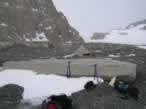Yet another day of sampling (I suppose, if we are lucky, this will be a common theme for every journal entry), however we lost our bluebird weather. The wind crept up to about 16 kts, with gusts of about 30 kts. Everything around was a bit dim, with a thin veil of clouds overhead. I awoke this morning to the tent flapping, and went to find Pete was already up… He beat me! Luckily, he hadn’t made anything yet, so I had something to do.
We set off back towards the moraines near Treves Butte and Discovery Ridge, bypassing the trip out to the Bennett Nunataks on account of the flat light impeding the surface definition needed for identifying crevasses. Today I got to drive a ski-doo, an opportunity which I welcomed after yesterday’s endurance trip in the Siglin. We arrived back at the gorge between Treves Butte and Discovery Ridge, and chose to sample the moraine on the Treves Butte side (probably the northern continuation of the ‘Discovery Ridge’ moraine, with the midsection covered by snow blowing through the gorge). Before lunch I sampled a basalt cobble that was cemented into a tillite boulder. Noticeable cubes of clinopyroxene could be viewed with a hand lens, thus providing great material for using helium to derive an exposure age. Hopefully the cobble is derived from lodgement, which supposedly was never previously exposed. To think that that boulder was glacially abraded, transported, and then deposited way back in the Permian, and then sat around for millions of years, and then was picked up again, and redeposited in a till composed partially of tillite!
We hammered away for a while longer, until the wind finally convinced
us it was time to go back to camp. The number of samples should
be sufficient to constrain the ages of the ice-cored moraines near Discovery Ridge. Once
back at camp, I cooked a steak dinner. I cooked the steak over a low heat in a
pan greased with butter and dehydrated onions, and sprinkled the meat with salt,
pepper, garlic powder, basil and parsley. Everyone seemed to prefer medium
steaks, so I tried my best. I accompanied the entrée with scalloped
potatoes cooked with mozzarella and Monterey jack cheese, and sautéed
vegetables. It was a simple meal, but it sounded like the scientists enjoyed
it (or at least said they did). A data-entry session with Sujoy followed,
and it was off to bed. We all eagerly anticipate venturing into the Bennet
Nunataks region to see what surprises lie in wait…

